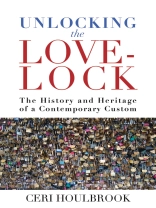Explores the worldwide popularity of the love-lock as a ritual token of love and commitment by considering its history, symbolism, and heritage.
“[T]his is an eminently enjoyable and thorough investigation of a popular phenomenon through the lens of heritage and folk tradition.”—Sara De Nardi, Western Sydney University
A padlock is a mundane object, designed to fulfil a specific – and secular – purpose. A contemporary custom has given padlocks new significance. This custom is ‘love-locking’, where padlocks are engraved with names and attached to bridges in declaration of romantic commitment. This custom became popular in the 2000s, and its dissemination was rapid, geographically unbound, and highly divisive, with love-locks emerging in locations as diverse as Paris and Taiwan; New York and Seoul; Melbourne and Moscow.
From the introduction:
I was distractedly perusing the photo frame aisle, my eyes skimming the generically sentimental stock pictures of happy families smiling at the camera, pretty landscapes, cute pets and couples walking hand-in-hand, when I came across one that jumped out at me…. I recognised the image instantly as a photograph of love-locks: the padlocks that had been appearing en masse on bridges and other public structures on a global scale since the early 2000s. And, having been researching the custom known as lovelocking for about five years at that point, it was with a peculiar sense of pride that I realised love-locks had accomplished the status of a stock image.
Spis treści
List of Illustrations
Introduction
Chapter 1. Dating Love: A History of The Love-Lock Custom
Chapter 2. Consuming Love: Folk Custom and Popular Culture
Chapter 3. Excavating Love: The Material Culture of Love-Locking
Chapter 4. Locking Love: The Ethnography of Love-Locking
Chapter 5. Symbolizing Love: The semiotics of love-locking
Chapter 6. Selling Love: The Commercialization of Love-locking
Chapter 7. Unlocking Love: Controversy and Heritage
Concluding Thoughts: A Final Case-Study
Appendix 1
Appendix 2
Bibliography
O autorze
Ceri Houlbrook attained her doctorate in Archaeology from the University of Manchester, and is a lecturer in Folklore and History at the University of Hertfordshire. Her primary research interests are contemporary folklore and the material culture of popular customs and beliefs. She has published previously on the British phenomenon of coin-trees and the history and folklore of concealed objects.












